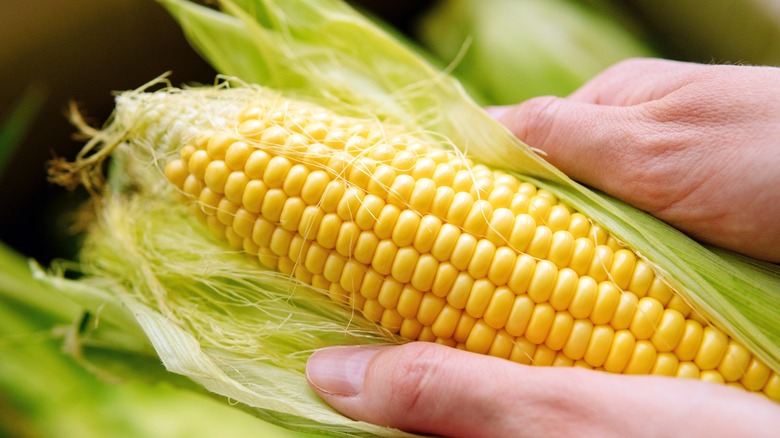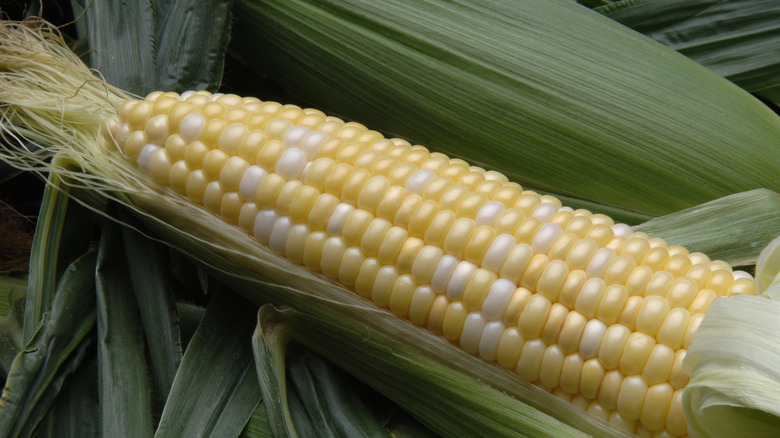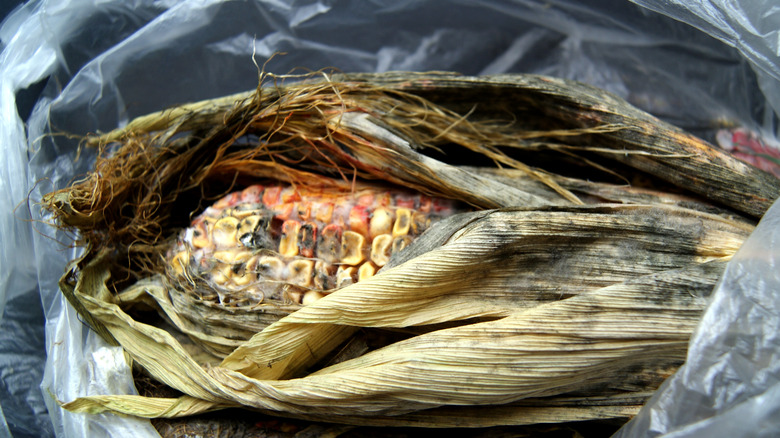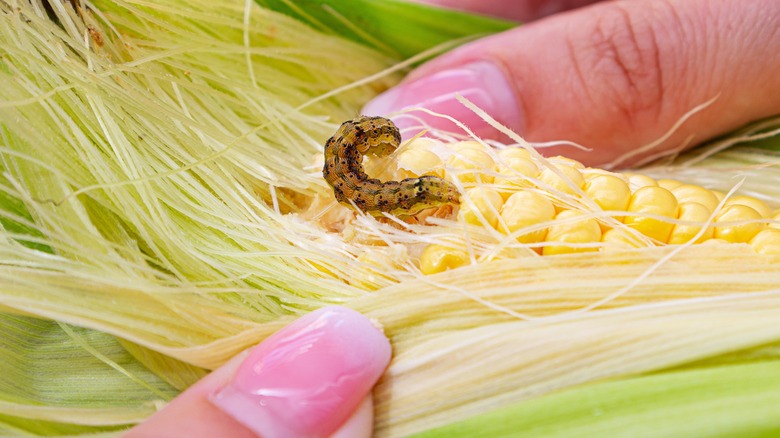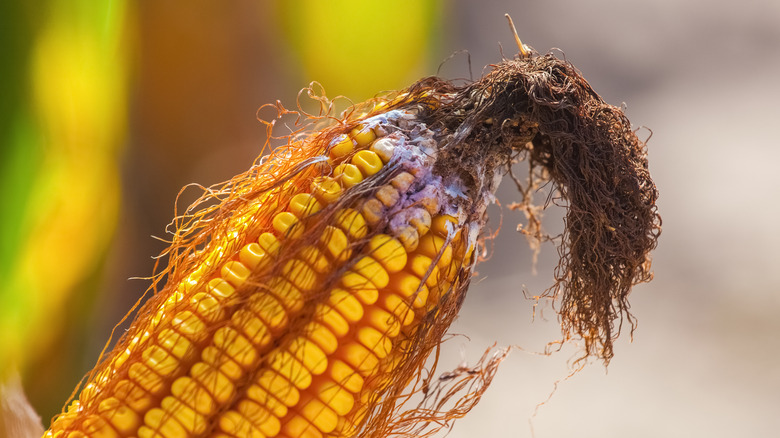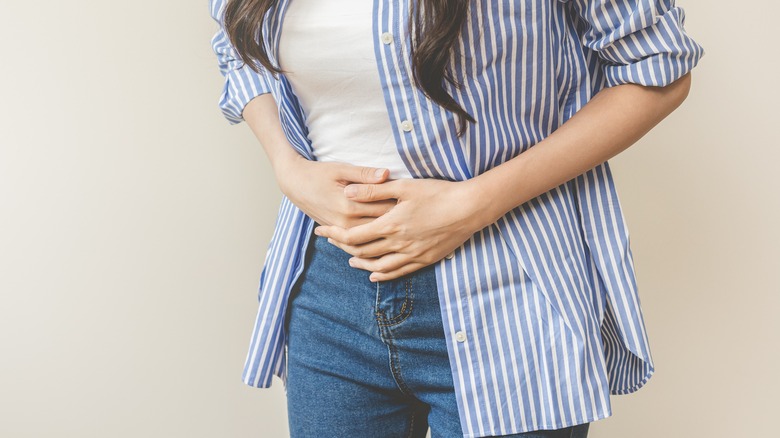How To Tell If Corn On The Cob Has Gone Bad
In the United States, corn season lasts from May to September. During those months, fresh corn is plentiful, piled up in grocery stores and farmers' markets, ready to grill or turn into piping hot elotes.
However, corn won't stay sweet and flavorful for long — the sugars that give it its flavor start degrading as soon as it leaves the stalk, and it's prone to losing moisture. Ideally, you'll be able to eat corn the same night you get it, but sometimes life has other plans. If you can't eat it immediately, how long will it last?
According to FoodSafety.gov, corn on the cob should be stored in the refrigerator and eaten within 1 to 2 days of the date of purchase for optimal freshness. Don't worry if you can't consume your corn right away, though. It can be frozen, too — and it will keep for up to 8 months in the freezer. Cooked corn lasts a little longer: you can keep it for 4 to 5 days in the fridge.
How to best store corn on the cob to keep it fresh
If the corn still has its husks, don't shuck it — the husks help protect the ear and keep the kernels fresh and moist. Instead, store it in the crisper drawer of your refrigerator until you're ready to use it. However, if you're stuck with pre-shucked ears, put them in an airtight bag or container to help preserve moisture. That's how cooked corn on the cob should be stored, too.
If you're freezing corn, the rules are a little different. When freezing corn on the cob, you should always blanch the ears beforehand. Blanching, a technique that involves boiling the ears for a few quick minutes, helps preserve color, flavor, and texture.
To blanch the ears, remove the husks and set a large pot of water to boil. Drop the ears in — making sure you don't crowd the pot — and cook them for 3 to 4 minutes. Once they've become slightly tender, dunk them in a bowl of ice water to cool. Dry the ears on paper towels before stacking them in a freezer bag and putting them in the freezer.
Signs corn on the cob has gone bad
While you should check the husks before shucking corn, brown, dry, or slightly slimy husks, don't necessarily mean the corn itself is inedible, according to the Greater Chicago Food Depository. The real telltale signs that corn is past its prime come once the husks come off. If your corn feels slimy, smells off, or is visibly bruised, throw it away. You should also toss corn immediately if you spot any mold or discoloration. Mold can cause serious health complications, so err on the side of caution.
However, not everything that grows on an ear of corn is bad for you. Huitlacoche, a bulbous, blue-gray fungus that sprouts straight from the cob, is a Mexican delicacy. The fungus, which is often compared to truffles, is a popular quesadilla filling. It has other uses, too — Mexican chefs use it in sauces and alongside meats.
In the United States, huitlacoche is called "corn smut" and is considered a blight. Farmers go to great lengths to avoid it, so you probably won't find it on the corn you buy from the store. Even if you do find a growth that looks like it might be huitlacoche, it's a good idea to toss the whole ear — it's not worth the risk if it turns out to be regular mold. However, if you find huitlacoche being sold by a reputable farmer, consider giving it a try.
Can you eat corn on the cob if there's a worm in it?
If a little mold is bad, a wriggling worm must be even worse, right? Not necessarily. Finding a worm in your corn may be gross, but it's most likely a corn earworm, a common but harmless pest. The worms — which are technically caterpillars — tend to hang out around the silky end of the ear, leaving the rest of the cob untouched.
As the Colorado Sun reports, the ear should be safe to eat unless it's seriously gnawed. Simply cut off the chewed end and scrub down the ear. You may want to give the ear an extra once-over before you cook it, but you probably won't find more worms. The cannibalistic creatures eat competitors, so there's typically just one per cob.
Of course, you're free to throw out the ear. However, if you're buying organic produce, be prepared to trash a lot of corn. Corn earworms are very common and very hard to control without extensive pesticide use. If you find a worm in your corn, try to take it in stride and view it as a sign that the produce wasn't doused in pesticides.
Can you eat corn on the cob if there's mold on a few kernels?
Yes, it's disappointing to have just a small spot of mold ruin an entire ear of corn — especially if it was a big part of your dinner plans. However, as the United States Department of Agriculture explains, you should always throw out moldy food, even if you only see a little bit of discoloration. Corn is considered a "softer" food, which means that mold can spread easily through the ear, even if it looks like only a small part is damaged.
Like the tip of an iceberg, you're only seeing part of the mold. The rest grows deep into the food, spreading "roots" throughout the rest of the ear. These roots can contain toxins that could make you sick. Toss corn that has mold on the silk or husks, too — It's just not worth the risk.
What happens if you eat old corn on the cob?
If you accidentally eat old corn on the cob, you'll probably be okay — but you should keep an eye out for signs of food poisoning or an allergic reaction to mold. According to Healthline, eating a small amount of mold probably won't hurt you, especially if you have a healthy immune system and no mold allergies. However, the Cleveland Clinic explains that you should seek medical help if you think you've had an allergic reaction. Symptoms include shortness of breath, nausea, diarrhea, or fever.
Like any food, corn can also cause food poisoning. Symptoms of food poisoning include nausea, vomiting, diarrhea, stomach pain, or fever. If you experience those symptoms after eating an iffy piece of corn, take care — and seek medical help immediately if you can't keep liquids down, feel dehydrated, have a fever over 102 degrees Fahrenheit, see blood in your diarrhea, or have diarrhea that lasts more than three days.
How to select the freshest corn on the cob
Sometimes, it's easy to pick the freshest fruits and vegetables from the grocery store. With just a glance, you can tell that a brown apple or wrinkled tomato has gone bad. Corn is trickier, though. How can you tell if corn is fresh without shucking the whole thing?
While you might not be able to check the kernels for optimum freshness, you can tell a lot from the husks and silk. First, check the silk. It should be pale yellow or just slightly brown, not dark brown or black. Feel the silk, too. It should feel slightly sticky or damp but not mushy.
Next, check the husk. It should be bright green, tight against the ear, and slightly damp to the touch. Pick the corn up, turn it over to make sure that there aren't any insect holes or bruises, and give it a heft. The corn should be heavy for its size, too — that means it's nice and juicy.
It might be tempting to buy those plastic-wrapped pre-shucked ears, but you should veto them if possible. Husks help preserve flavor and moisture, so corn that has been sitting shucked for hours or days will likely be dry and flavorless. If you're left with no other choice but to buy pre-shucked ears, try to eat them the same day.
